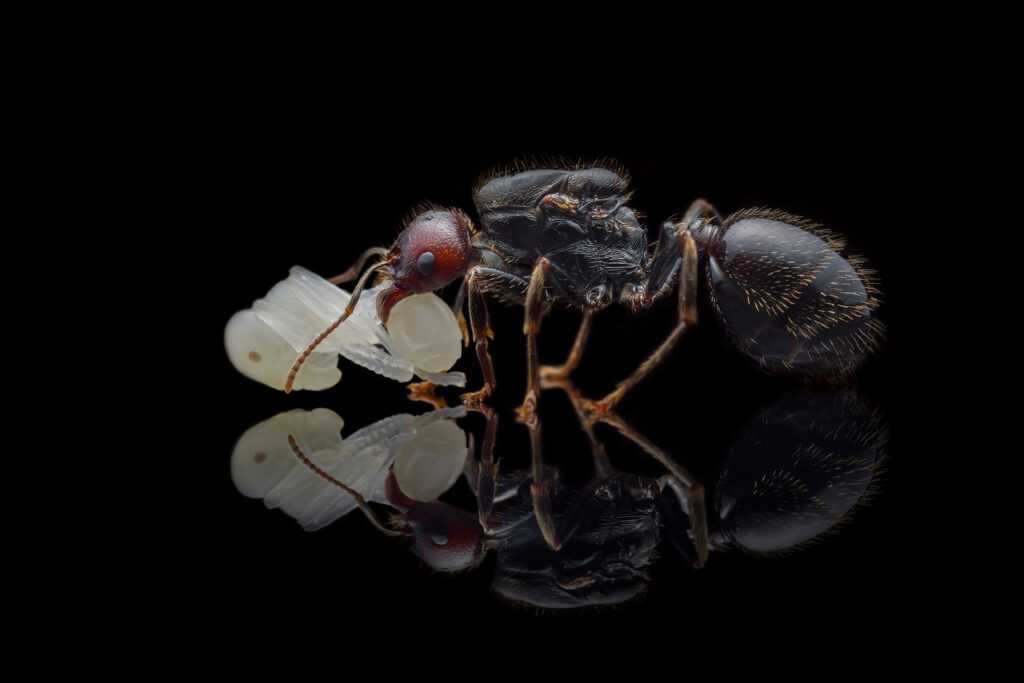Pheidole vulgaris
Welcome to the world of Pheidole vulgaris, a fascinating ant species known for its small size, aggressive nature, and impressive colony size. In this product description, we will explore the key features and benefits of owning a Pheidole vulgaris colony, including their colony type, development speed, size, nutrition, humidity and temperature preferences, and recommended nests for breeding.
Colony Type: Polygyny
Pheidole vulgaris colonies are polygynous, meaning they have multiple queens. This unique characteristic sets them apart from many other ant species and allows for a larger, more robust colony. With polygyny, Pheidole vulgaris colonies can reach an impressive size of up to 50,000 workers, making them a captivating species to observe and study.
Development Speed: Fast
One of the notable advantages of Pheidole vulgaris is their fast development speed. From the egg stage to the worker ant stage, these ants progress quickly, allowing you to witness their growth and expansion at an impressive rate. This rapid development adds excitement and dynamics to your ant-keeping experience.
Size
Pheidole vulgaris ants come in various sizes, with distinct measurements for queens, workers, and majors.
- Queen: The queens measure approximately 7-9 mm in length. They possess a unique coloration – a black body with a red abdomen, which adds to their visual appeal.
- Workers: The worker ants are smaller, ranging between 2.5-4 mm in size. While small, they play a crucial role in the colony, undertaking tasks such as foraging for food and caring for the brood.
- Majors: Pheidole vulgaris majors are the larger caste within the colony, measuring between 4.5-7 mm. With their size and strength, majors are responsible for defending the colony and can often be identified by their unique head shape.
Color
The coloration of Pheidole vulgaris ants adds to their allure. The body color is predominantly yellowish-brown, whereas the queens exhibit a striking contrast with their black bodies and red abdomens. This vibrant color combination makes them visually captivating and a standout addition to any ant collection.
Nutrition
In order to maintain a healthy and thriving Pheidole vulgaris colony, it is crucial to provide them with a varied and balanced diet. These ants are not picky eaters and have quite a broad range of preferred foods. Their diet should consist of:
- Insect food: Pheidole vulgaris ants have a natural inclination towards insects such as cockroaches and crickets, making them an effective natural pest control option.
- Syrup: Providing a syrup mixture of water and honey in ratios of 4:1, 3:1, or 2:1 offers a source of energy for the ants. This sugar-rich solution helps them meet their dietary needs.
- Fruits and Vegetables: Fresh fruits and vegetables provide essential nutrients, vitamins, and hydration for the colony. They eagerly feast on options such as apples, strawberries, lettuce, and cucumber.
- Jelly: Ant jellies, commercially available or homemade, can be an excellent source of supplementary nutrition for Pheidole vulgaris ants.
- Cooked Chicken without Salt: Offering cooked chicken without salt provides an additional protein source for the colony. Ensure the chicken is thoroughly cooked and devoid of any seasoning.
By providing a diverse range of food options, you can ensure the optimal health and well-being of your Pheidole vulgaris colony, promoting their growth and productivity.
Humidity and Temperature
Pheidole vulgaris ants have specific preferences for both humidity and temperature in their environment.
Humidity:
- Arena: The humidity in the arena or foraging area should be maintained at a range of 50-70%. To achieve this, misting the area with distilled water or using a humidifier can be beneficial.
- Nest: Inside the nest, Pheidole vulgaris ants prefer a slightly higher humidity level, around 70-80%. The nest can be humidified using various methods such as sponges, water towers, or converting parts of the nest into water chambers.
Temperature:
- Arena: The temperature in the arena or foraging area should ideally range between 25-28 °C. Ensuring a stable and comfortable temperature for the ants will promote their activity and overall well-being.
- Nest: Within the nest, maintaining a temperature range of 21-26 °C is essential. This can be achieved by using heating cables, heat mats, or placing the nest in a temperature-controlled room.
By regulating the humidity and temperature within the recommended ranges, you can create an environment conducive to the growth and prosperity of your Pheidole vulgaris colony.
Species Feature
Pheidole vulgaris ants are not only small in size but also possess a remarkable trait – they can consume grains. This unique dietary habit sets them apart from many other ant species and can be an interesting addition to observing their foraging behavior.
Recommended Nests for Breeding
Providing a suitable nest for breeding is crucial for the well-being and expansion of a Pheidole vulgaris colony. The following nest types are recommended:
- Acrylic Nests: These nests offer visibility and ease of maintenance, allowing you to observe the ants’ activities and clean the nest effectively.
- Gypsum Nests: Gypsum nests provide a more natural and aesthetically appealing environment for the ants. They offer good humidity retention, promoting the ants’ comfort and well-being.
- Aerated Concrete Nests: Aerated concrete nests are known for their durability and excellent insulating properties. They help maintain stable temperatures and humidity levels, creating an optimal living space for the ants.
By selecting the right nest type, you can provide your Pheidole vulgaris colony with a comfortable and secure home, enabling them to thrive and reach their full potential.
In conclusion, Pheidole vulgaris is an intriguing ant species, brimming with unique features and benefits. From their polygynous colony structure and fast development speed to their captivating colors and dietary habits, these ants offer a fulfilling and educational ant-keeping experience. By providing them with the right nutrition, maintaining the appropriate humidity and temperature levels, and selecting suitable nests for breeding, you can ensure the longevity and success of your Pheidole vulgaris colony.

















Reviews
There are no reviews yet.